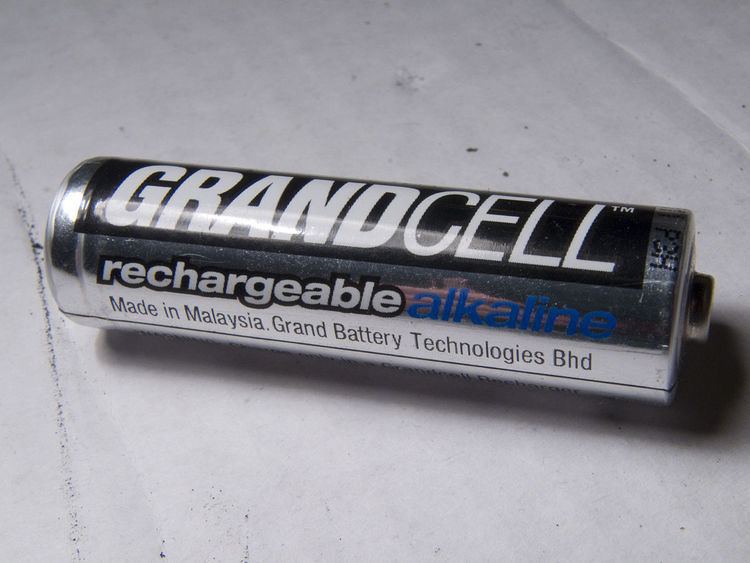 | ||
A rechargeable alkaline battery (also known as alkaline rechargeable or rechargeable alkaline manganese (RAM)) is a type of alkaline battery that is capable of recharging for repeated use. The first-generation rechargeable alkaline technology was developed by Battery Technologies Inc in Canada and licensed to Pure Energy, EnviroCell, Rayovac, and Grandcell. Subsequent patent and advancements in technology have been introduced. The formats include AAA, AA, C, D, and snap-on 9-volt batteries. Rechargeable alkaline batteries are manufactured fully charged and have the ability to hold their charge for years, longer than NiCd and NiMH batteries, which self-discharge. Rechargeable alkaline batteries can have a high recharging efficiency and have less environmental impact than disposable cells.
Contents
Proper use and durability
Most alkaline batteries available are disposable, designed to be used until exhausted, then discarded. There are also rechargeable alkaline batteries, designed to be recharged.
Disposable alkaline batteries are classed as primary batteries; manufacturers do not support recharging, and warn that it may be dangerous. Despite this advice, alkaline batteries have successfully been recharged, and suitable chargers have been available. The capacity of a recharged alkaline battery declines with number of recharges, until it becomes unusable after typically about ten cycles.
Low-ripple direct current is not suitable for charging disposable alkaline batteries; more suitable is a current pulsed at a rate of 40 to 200 pulses per second, with an 80% duty cycle. Pulsed charging appears to reduce the risk of electrolyte—usually potassium hydroxide (KOH)—leakage. The charging current is low to prevent rapid production of gases that can rupture the cell. Cells that have leaked electrolyte are a safety hazard and unsuitable for reuse. Fully discharged cells recharge less successfully than only partly depleted cells, particularly if they have been stored in a discharged state —battery charger manufacturers do not claim to recharge dead cells.
Attempting to recharge a discharged alkaline battery can cause the production of gas within the canister. As the canister is normally sealed, pressure generated by rapid accumulation of gas can open the pressure relief seal and cause leakage of electrolyte. Potassium hydroxide in the electrolyte is corrosive and may cause injury and damage, particularly corroding the battery contacts in the equipment.
Some materials used in batteries are damaging to the environment. In some jurisdictions it is illegal to dispose of batteries in ordinary waste streams. Free collection points for used portable batteries are often available where batteries are sold.
As an alkaline battery is discharged, chemicals inside the battery react to create an electric current. However, once the chemicals have reached chemical equilibrium, the reaction stops, and the battery is depleted. By driving a current through the battery in the reverse direction, the equilibrium can be shifted back towards the original reactants. Different batteries rely on different chemical reactions. Some reactions are readily reversible, some are not. The reactions used in most alkaline batteries fall into the latter category. In particular, the metallic zinc generated by driving a reverse current through the cell will generally not return to its original location in the cell, and may form crystals that damage the separator layer between battery anode and electrolyte.
Although these batteries can be used in any device that supports a standard size (AA, AAA, C, D, etc.), they are formulated to last longest in periodical use items. This type of battery is better suited for use in low-drain devices such as remote controls or for devices that are used periodically such as flashlights, television remote control handsets, portable radios, etc. If they are discharged by less than 25%, they can be recharged for hundreds of cycles to about 1.42 V. If they are discharged by less than 50%, they can be almost fully recharged for a few dozen cycles, to about 1.32 V. After a deep discharge, they can be brought to their original high-capacity charge only after a few charge-discharge cycles.
Comparison to other rechargeable batteries
The rechargeable alkaline battery is cheaper than other rechargeable types. Cells can be manufactured in the fully charged state and retain capacity well. Their capacity is about 2/3 that of primary cells. They are of dry-cell construction, completely sealed and not requiring maintenance. Cells have a limited cycle life, which is affected by deep discharge; the first cycle gives the greatest capacity, and if deeply discharged a cell may only provide 20 cycles. The available energy on each cycle decreases. Like primary alkaline cells, they have a relatively high internal resistance, making them unsuitable for high discharge current (for example, discharging their full capacity in one hour).
Chemical composition
Rechargeable alkaline batteries are developed from primary alkaline batteries, designed to resist leakage that a recharge could cause, so they can be safely recharged many times.
Some other types of rechargeable cells contain mercury or cadmium and thus can be an environmental hazard unless disposed of properly. As of August 2007, a number of companies make batteries that are free from these heavy metals. According to the websites of EnviroCell and PureEnergy and according to old Rayovac packaging, these manufacturers' rechargeable alkaline batteries have no mercury or cadmium.
